Developmental differences in structure of attention-deficit/hyperactivity disorder (ADHD) between childhood and adulthood
- PMID: 25635150
- PMCID: PMC4307607
- DOI: 10.1177/0165025412444077
Developmental differences in structure of attention-deficit/hyperactivity disorder (ADHD) between childhood and adulthood
Abstract
The current paper utilizes a bifactor modeling approach to evaluate the structure of attention-deficit/hyperactivity disorder (ADHD) in adulthood and assess developmental continuity of ADHD structure between childhood and adulthood. The study compared traditional one-factor, two-factor, three-factor, and second-order factor models of ADHD with a bifactor model of ADHD. Developmental differences in ADHD structure were examined using an extension of the bifactor model: a two-group model comparing children and adults. Participants were 406 adults (49% male; 145 of 406 with ADHD), (18 to 37) years old, and 548 children (58% male; 302 of 548 with ADHD), 6 to 18 years old. A bifactor model of ADHD exhibited the best fit in adults and children compared to traditional models, suggesting continuity in the ADHD latent construct across development. However, significant differences in the factor loadings were evident between children and adults in the two-group bifactor model, suggesting changes in the relative importance of particular symptoms over time. Namely, hyperactivity symptoms appear to decline in importance relative to the ADHD phenotype between childhood and adulthood.
Keywords: attention problems; children; development; developmental psychopathology.
Figures
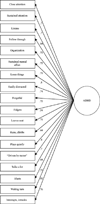
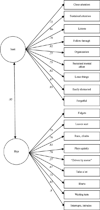
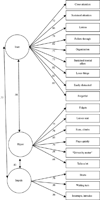
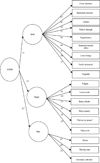
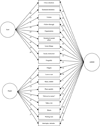

References
-
- Achenbach T. Manual for the child behavior checklist/4–18 and 1991 profile. Burlington, VT: University of Vermont, Department of Psychiatry; 1991a.
-
- Achenbach T. Manual for the young adult self report and young adult behavior checklist. Burlington, VT: University of Vermont, Department of Psychiatry; 1991b.
-
- Amador-Campos JA, Forns-Santacana M, Martorell-Balanzo B, Guardia-Olmos J, Pero-Cebollero M. Confirmatory factor analysis of parents’ and teachers’ ratings of DSM-IV symptoms of attention deficit hyperactivity disorder in a Spanish sample. Psychological Reports. 2005;97:847–860. - PubMed
-
- Amador-Campos JA, Forns-Santacana M, Martorell-Balanzo B, Guardia-Olmos J, Pero-Cebollero M. DSM-IV attention deficit hyperactivity disorder symptoms: Agreement between informants in prevalence and factor structure at different ages. Journal of Psychopathology and Behavioral Assessment. 2006;28:23–32.
-
- American Psychiatric Association. Diagnostic and statistical manual of mental disorders. 4th ed. Washington, DC: American Psychiatric Association; 2000. text rev.
Grants and funding
LinkOut - more resources
Full Text Sources
